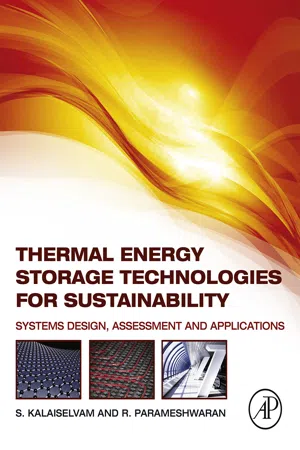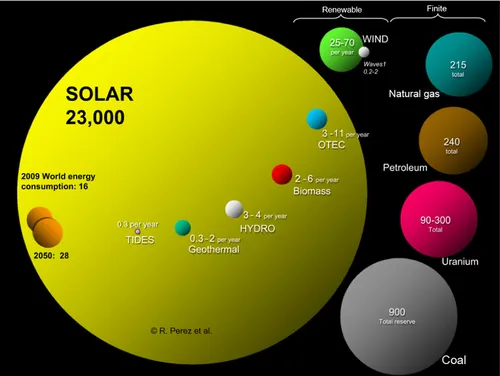
eBook - ePub
Thermal Energy Storage Technologies for Sustainability
Systems Design, Assessment and Applications
S. Kalaiselvam,R. Parameshwaran
This is a test
- 444 pagine
- English
- ePUB (disponibile sull'app)
- Disponibile su iOS e Android
eBook - ePub
Thermal Energy Storage Technologies for Sustainability
Systems Design, Assessment and Applications
S. Kalaiselvam,R. Parameshwaran
Dettagli del libro
Anteprima del libro
Indice dei contenuti
Citazioni
Informazioni sul libro
Thermal Energy Storage Technologies for Sustainability is a broad-based overview describing the state-of-the-art in latent, sensible, and thermo-chemical energy storage systems and their applications across industries. Beginning with a discussion of the efficiency and conservation advantages of balancing energy demand with production, the book goes on to describe current state-of-the art technologies. Not stopping with description, the authors also discuss design, modeling, and simulation of representative systems, and end with several case studies of systems in use.
- Describes how thermal energy storage helps bridge the gap between energy demand and supply, particularly for intermittent power sources like solar, wind, and tidal systems
- Provides tables, illustrations, and comparative case studies that show applications of TES systems across industries
- Includes a chapter on the rapidly developing field of viable nanotechnology-based thermal energy storage systems
Domande frequenti
Come faccio ad annullare l'abbonamento?
È semplicissimo: basta accedere alla sezione Account nelle Impostazioni e cliccare su "Annulla abbonamento". Dopo la cancellazione, l'abbonamento rimarrà attivo per il periodo rimanente già pagato. Per maggiori informazioni, clicca qui
È possibile scaricare libri? Se sì, come?
Al momento è possibile scaricare tramite l'app tutti i nostri libri ePub mobile-friendly. Anche la maggior parte dei nostri PDF è scaricabile e stiamo lavorando per rendere disponibile quanto prima il download di tutti gli altri file. Per maggiori informazioni, clicca qui
Che differenza c'è tra i piani?
Entrambi i piani ti danno accesso illimitato alla libreria e a tutte le funzionalità di Perlego. Le uniche differenze sono il prezzo e il periodo di abbonamento: con il piano annuale risparmierai circa il 30% rispetto a 12 rate con quello mensile.
Cos'è Perlego?
Perlego è un servizio di abbonamento a testi accademici, che ti permette di accedere a un'intera libreria online a un prezzo inferiore rispetto a quello che pagheresti per acquistare un singolo libro al mese. Con oltre 1 milione di testi suddivisi in più di 1.000 categorie, troverai sicuramente ciò che fa per te! Per maggiori informazioni, clicca qui.
Perlego supporta la sintesi vocale?
Cerca l'icona Sintesi vocale nel prossimo libro che leggerai per verificare se è possibile riprodurre l'audio. Questo strumento permette di leggere il testo a voce alta, evidenziandolo man mano che la lettura procede. Puoi aumentare o diminuire la velocità della sintesi vocale, oppure sospendere la riproduzione. Per maggiori informazioni, clicca qui.
Thermal Energy Storage Technologies for Sustainability è disponibile online in formato PDF/ePub?
Sì, puoi accedere a Thermal Energy Storage Technologies for Sustainability di S. Kalaiselvam,R. Parameshwaran in formato PDF e/o ePub, così come ad altri libri molto apprezzati nelle sezioni relative a Technik & Maschinenbau e Energieressourcen. Scopri oltre 1 milione di libri disponibili nel nostro catalogo.
Informazioni
Argomento
Technik & MaschinenbauCategoria
EnergieressourcenChapter 1
Energy and Energy Management
Abstract
Energy is the lifeline of all human activities and the chief catalyst for the overall development of the key sectors within a country. The role of energy sources and proper energy management techniques can be considered the decisive factors that merit the economic potential status for a developed country among the world’s nations. The challenges pertaining to the extraction, generation, and distribution of energy have to be confronted at every step of the energy-efficient systems design. This would help acheive the energy conservation potential as well as carbon emissions reduction. The development of state-of-the art technologies amalgamated with renewable energy integration would contribute to offsetting the future energy demand/consumption without sacrificing energy efficiency and environmental sustainability.
Keywords
Energy
Energy management
Energy efficiency
Environmental sustainability
Energy conservation
Energy consumption
Energy sources
Renewable energy integration
Sustainability
1.1 Introduction
Energy and energy management are two facets of a mature technology that would move the economic status of a country from normal to the height of societal development. A nation with a strong mission of ensuring energy efficiency at each step of its societal development can sustain higher economic growth on a long-term basis. The increasing concerns about climate change and environmental emissions have led to conserving energy through the development of several energy-efficient systems. The underlying concept behind this is the reduction of extensive utilization of fossil fuel or primary energy sources and their associated carbon emissions. From this perspective, the following sections are designed to explain energy concepts, project energy demand/consumption, and describe possible energy management techniques that would be helpful for the development of a sustainable future.
1.2 Energy Resources, Energy Sources, and Energy Production
In the spectrum of energy and energy management, energy resources, energy sources, and energy production are extremely vital starting from their discovery, conversion, and production to end-use consumption. Although the terminologies related to energy resources and energy sources seem to be associated, a basic difference exists that helps the scientific community to move the task of energy production forward to meet energy demand.
Energy resource refers to a reserve of energy, which can be helpful to mankind and society in many ways. On the other hand, energy source also means the system that is devised for extracting energy from the energy resource. For example, the availability of fossil fuels under the earth in the form of coal can be categorized as an energy resource. The system or the technology that is incorporated to extract the energy available from the fossil fuel (coal) can be classified as the energy source.
Earth has large energy resources or basins including solar, hydro, wind, biomass, ocean, and geothermal. Through the application of the human ideologies and emerging technologies, tapping the energy from these reserves in an efficient manner has always been a paramount task. Earth’s finite and renewable energy reserves along with recoverable energy from these resources are depicted in Fig. 1.1.

Figure 1.1 Finite and renewable planetary energy reserves (Terawatt-years, TWy). Total recoverable reserves are shown for the finite resources. Yearly potential is shown for the renewable [1].
It is not only important that the energy be extracted from these reserves or reservoirs; the real success of the task depends on efficient transformation to the actual societal requirements. In simpler words, the extracted e...